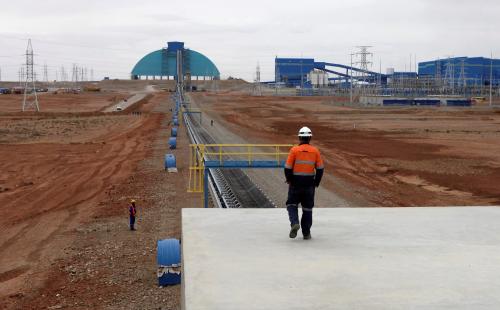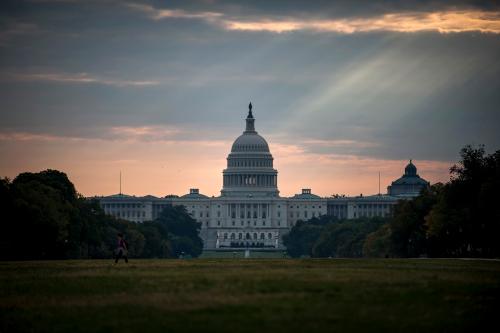Over the course of a decade, Mongolia has implemented a series of interlinked laws and reforms relating to the transparency of corporate ownership. These efforts have the potential to combat everything from corruption to anti-democratic governance trends, to money laundering and terrorism financing. In particular, two of those objectives—combating money laundering and terrorism financing—are currently better positioned for success, with others lagging. To understand why, we unpack the divergences between the reform goals and the organizations pushing for them. We also highlight several recommendations for advancing the anti-corruption dimension of reform, based upon the Leveraging Transparency to Reduce Corruption (LTRC) initiative’s report “Beneficial Ownership in Mongolia: A Way Forward.”
Background
In late 2019, when Mongolia was placed on the Financial Action Task Force (FATF) “grey list” of jurisdictions that have flawed systems for countering money laundering and terrorism financing, the implications were serious enough that the nation redoubled its efforts to reverse the designation. Being placed on the grey list was a clear warning: FATF, the globe’s leading financial crimes watchdog, had determined that the nation was at a higher risk for supporting money laundering and terrorism financing than other countries. But, in almost record time—within a year—Mongolia was off the grey list.
Landing on the grey list threatened a series of damaging international penalties. Mongolia ultimately could have been blacklisted by FATF and consequently would have faced a swirl of sanctions. For instance, Pakistan is thought to have lost an estimated $38 billion in GDP attributable to its decade-long presence on the grey list.
A number of factors had led to Mongolia’s inclusion on the grey list, chiefly relating to its insufficient investigations, prosecution, and enforcement of anti-money laundering provisions.
Among the issues FATF pressed Mongolia on was the poor effectiveness of its system for transparency regarding legal entities operating in the nation. In other words, its beneficial ownership disclosure system was subpar.[1] That inadequacy was a danger sign to FATF.
Throughout the world, shadowy shell corporations find refuge in countries without adequate beneficial ownership systems in order to transfer and hide money. They are prime vehicles for money laundering and terrorism financing, which is the primary focus of FATF. And FATF assessed that companies operating in Mongolia were largely confident that the public or perhaps even the government would remain in the dark about who ultimately owned or controlled their businesses. FATF concluded that although Mongolia technically had an adequate beneficial ownership disclosure system, its effectiveness was low.
Mongolia’s Efforts to Shine a Light on Shadowy Corporate Ownership
Driven in part by its desire to be taken off the FATF grey list, Mongolia undertook a number of reforms, including amendments to the General Law on State Registration and the creation of a stronger legal obligation to disclose beneficial ownership information.
This was not, however, the first time that the country had modified its beneficial ownership regime in response to international pressure. Almost a decade ago, efforts to meet the Extractive Industries Transparency Initiative (EITI) standard had also propelled Mongolia to improve beneficial ownership disclosure.
In both cases—EITI compliance and FATF grey delisting—the initial surge in activity dissipated, and reformers were left wondering whether the goals of FATF or EITI would be met.
A Swirl of Use Cases and Signposts for Success
Going forward, LTRC’s report, “Beneficial Ownership in Mongolia: A Way Forward,” details a series of next steps and recommendations for Mongolia to fully embrace and implement beneficial ownership transparency. The report helps explain a key issue that beneficial ownership transparency proponents need to be precise about. The transparency they advocate for has multiple use cases. Disclosure regimes crafted in ways to address one set of problems may not be tailored to a different set.
The contrast between EITI and FATF’s chief goals—and the differences in the beneficial ownership systems they promote—illustrates this point. EITI focuses on open and accountable natural resource management and consequently has a significant corruption emphasis. FATF concentrates on money laundering and terrorism financing. While often there is overlap between money laundering or terrorism financing and corruption, it is not a perfect intersection by any means. As a result, the uses of beneficial ownership transparency to tackle these problems are related but different. In particular, EITI and FATF treat the issue of Politically Exposed Persons (PEP) and beneficial ownership transparency differently.
Anti-corruption and EITI advocates are often concerned about potential conflicts of interest, where a PEP might have an ownership stake in an extractives or extractives-dependent company that motivates them to make decisions based on their personal finances rather than the public interest. A PEP’s ownership stake in an extractive company might be quite small from the perspective of the company, yet to the PEP, it could represent a significant portion of their wealth. As a result, the EITI standard for beneficial ownership transparency is clear: “the definition [of a beneficial owner] should specify reporting obligations for politically exposed persons.”
In contrast, FATF says nothing about PEPs in its beneficial ownership transparency recommendations. To be sure, PEPs are a matter of interest to FATF in other parts of its evaluation system, particularly with regard to “know your customer” practices for financial institutions, which is a process used by banks to track money to its ultimate owner in order to assess money laundering risk. Beneficial ownership disclosure for FATF, then, serves the goal of being able to trace financial flows, with little interest in how the money does or does not affect governance decisions.
The way EITI and FATF treat the ownership level for triggering a disclosure requirement in a transparency regime is consequently different. EITI, with its interest in PEPs with even low stakes in a company, suggests that an ownership stake as low as five percent should be considered. At least one EITI-implementing country, Ghana, has required beneficial ownership disclosure for PEPs no matter how low the stake, as noted in “A Way Forward”. In contrast, FATF does not mention PEPs and simply advocates for a 25 percent or lower trigger in general.
These differences help explain why the recent progress in Mongolia to mollify FATF is not enough from an anti-corruption perspective and why LTRC’s “A Way Forward” pushes for some specific improvements going forward. We now turn to the three following recommendations:
Recommendations
Leverage Civil Society Organizations to Monitor “Right to Information” Legislation
The ability of the public or civil society organizations to access beneficial ownership information in Mongolia has been a perennial issue. As “A Way Forward” notes, a key finding from the authors’ interviews is that “government agencies were more skeptical on making [beneficial ownership] information publicly available. They rather prefer to improve inter-governmental agency disclosure of [beneficial ownership] for the efficiency of their functions/roles.” From a money laundering or terrorism financing perspective, this attitude is not debilitating. After all, tackling money laundering or terrorism financing is primarily handled by government enforcement agencies.
However, tackling corruption is quite another matter. LTRC’s extensive work and research in this space has affirmed that public access to information coupled with public participation in anti-corruption efforts is critical. And this is the key reason why “A Way Forward” presses Mongolia to “ensur[e] that the public right to beneficial ownership information remains enshrined in the law and is implemented in such a way as to facilitate public access to the information.” In the corruption space, the ability of citizens, civil society organizations, and even other businesses to act as “many eyes” is vital.
Adopt a Strategic Approach to Verification for the Public Officials Asset Register
Mongolia’s approach to beneficial ownership transparency for PEPs is layered. Rather than requiring companies to take note of and disclose PEP ownership no matter how small the stake, the country requires that nearly 40,000 senior public officials annually disclose details of their business interests, property, and assets. However, this disclosure is not linked to the beneficial ownership register, nor is it well verified. Indeed, there are substantial doubts whether the required disclosure is accurate or complete.
The World Bank has noted that Mongolia’s efforts to penalize public officials for inaccurate disclosure have been weak at best.
Through the lens of FATF’s priorities, this disconnect is not especially problematic. Tracking money laundering or terrorist financial flows does not depend upon confirming whether an official at a regulatory agency has a small stake in a company. But it does matter when attempting to assess corruption risks. An official with a small interest in a company may not be able to use it for money laundering, but they certainly could make regulatory decisions based on how it would benefit them personally rather than in the public interest.
The World Bank has noted that Mongolia’s efforts to penalize public officials for inaccurate disclosure have been weak at best. As a result, PEPs can act with some level of impunity, confident that they can obscure ownership stakes that could present conflicts of interest. Improving the verification of the public officials’ asset register is critical, then, from an anti-corruption perspective.
Identify a Beneficial Ownership Transparency Champion
Mongolia’s efforts to implement beneficial ownership transparency have been intermittent for more than a decade. Yet, when FATF grey listed the country, it responded with alacrity. It revised its laws regarding money laundering or terrorism financing, improved the efficiency of its investigative and prosecutorial entities, and committed resources and personnel to the pursuit of FATF priorities. In the process, Mongolia strengthened a large network of government entities dedicated to combating the financial crimes that FATF focuses on.
Meanwhile, corruption-focused improvements to the beneficial ownership transparency regime have slowed. For instance, while Mongolia has legislated a beneficial ownership register and collected some beneficial ownership information, as previously noted, there are many issues with the type and quality of information collected as well as with the lack of public access to it. While there are many advocates for these enhancements in Mongolian civil society organizations, the anti-corruption community lacks a strong beneficial ownership transparency champion and cannot access anything like the relatively well-funded anti-money laundering infrastructure established within the government. Indeed, some of the stakeholder interviewees in “A Way Forward” “asserted that the personal business interests of individual parliament members and other PEPs may hinder the advancement of legislation supporting wider [beneficial ownership] disclosure.”
The academic literature suggests that anti-corruption disclosure regimes may be particularly difficult to implement because the very people charged with establishing them often are those who benefit from weak systems. The incentives to enact anti-corruption measures are misaligned. Without a strong champion, it is possible that FATF’s vision of beneficial ownership transparency will continue to grab the lion’s share of government attention while anti-corruption use cases will not receive the same focus.
FATF and EITI anti-corruption goals are neither rivals nor mutually exclusive. They are complementary. Achieving those objectives requires the use of many similar tools. However, it is important to acknowledge that there are differences in goals and priorities between the two. Anti-corruption advocates have long felt that the FATF listing and evaluation process could help them make significant headway but will only get them partway toward their target. “A Way Forward” attempts to lay out concrete objectives for further progress.
In June 2022, Mongolia launched its participation in the Opening Extractives program, following its adoption of a new law on the disclosure of beneficial ownership that became effective that month. In the coming years, Mongolia has the opportunity to incorporate the recommendations from “A Way Forward” through this program and as it implements its national anti-corruption strategy.
[1] For more discussion of beneficial ownership disclosure systems in Mongolia, see previous LTRC blogs.
-
Acknowledgements and disclosures
The authors would like to thank Robin Lewis, Caitlin Purdy, and Supriya Sadagopan for editorial assistance, as well as Max Knight, Caroline Pitman, and Kathryn Spurrier for fact-checking and copyediting assistance. They also thank Michael Barron and Tim Law, co-authors of the LTRC “Beneficial Ownership in Mongolia: A Way Forward” report and subsequent report on “Beneficial ownership transparency in Mongolia: Tackling complex implementation issues.”








Commentary
How the mix of use cases for beneficial ownership transparency can complicate the drive for reform
September 19, 2022